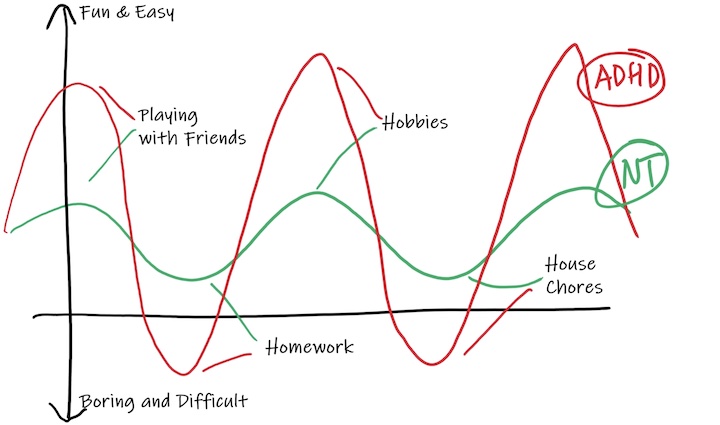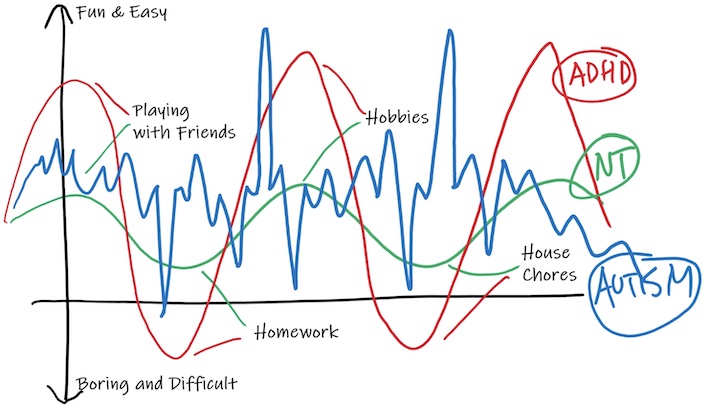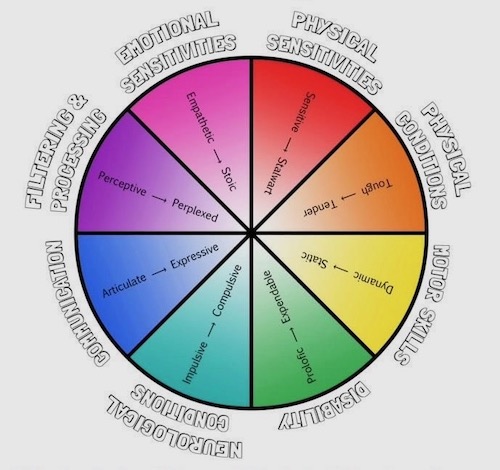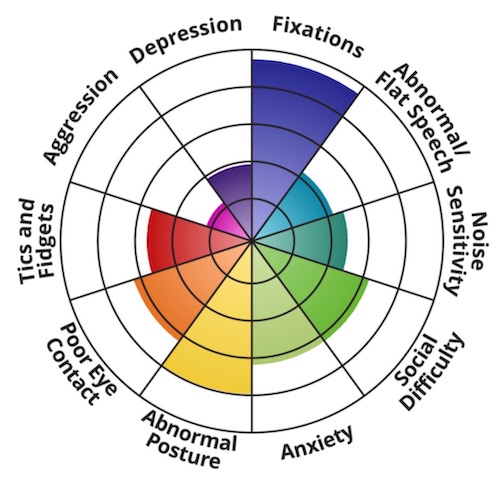What is Autism?
Neurodiversity
Neurodiversity is the idea that there are many different ways of wiring up a brain.
Neurotypicalis what it sounds like: the fundamental brain wiring that most people have.-
Neurodivergentis any non-typical brain wiring.Examples include ADHD, Epilepsy, OCD, Bipolar, Dyslexia, Dyspraxia, and many more distinctive brain wirings.
Note: Many people have more than one of these conditions (sometimes several) which can lead to massive difficulties in living life (aka disabilities), both intrinsic and social.
-
A
neurodiversegroup is any group that contains at least one neurodivergent person. - Fun fact: if you are in a group of six or more people, odds are that you are in a neurodiverse group.
- Even more fun fact: if you are ever in a group with me in it, you are also in a neurodiverse group, because I am Autistic, and Autism is yet another neurodivergent brain wiring.
ADHD and Autism
Most people could name several people they know who have been diagnosed with ADD or ADHD.
Autism and ADHD are very much cousins in the neurodivergent world, so lets talk about them for a minute.
Everyone has strengths and weaknesses, things that you find easy and hard to do. There are small variations, but most people find, for instance, socializing easier than homework, and hobbies easier than housework. For ADHD people the easy things become hyperfocus time sinks that are hard to break away from, while the hard things can become nearly impossible to reliably complete, even in small amounts.

This is your brain on ADHD.
Then there is Autism.
In many ways we Autistics are like ADHDers in that some things are very easy for us and can cause hyperfocus, and other things are very difficult ranging to impossible. But as you can see, we are even more different than ADHDers in respect to exactly which activities fall into these categories. Also every Autistic person is wildly different in both the positive or negative bias and degree of easiness or hardness of these activities. That is, something I find trivially easy to hyperfocus on for hours, another Autistic person might find nigh impossible to complete a 5 minute task in.

If you have met one…
There is a common saying for insular groups of people:
If you have met one <person from group X>, you have met them all.
We know (intellectually) this isn’t true, but like all generalizations, it is so tempting to believe sometimes.
The common saying in the Autistic community is different:
If you have met one <Autistic person>, you have met one (1) Autistic person.
I really can’t stress this enough, because it goes so strongly against that previous idiom. You sister’s Autistic kid is very different from the Autistic guy at church, who is very different from your Autistic coworker. The only generalization you as a neurotypical person can really make about Autistic people as a group is that we think differently than you do.
On the Spectrum
Another common misconception I want to address up front is the term “on the spectrum”
When we talk about things being “on a spectrum”, it’s usually represented as a linear gradient, ranging from opposite extremes, or from low to high.
So naturally, one begins to think of people as “more” Autistic or “less” Autistic. Or sometimes the metric is “functional adult”, so we say people are “high functioning” or “low functioning”.
Because Autistic people vary so wildly in abilities, linear gradients aren’t helpful analogies. Instead, consider Radar (aka Spider) charts, depicting several different linear gradients at the same time.


When we talk about the Autism Spectrum, we are talking about the multidimensional space we occupy that lays outside the “normal” distribution for neurotypicals. None of us gets to be “a little” Autistic any more than a woman gets to be “a little” pregnant. In much the same way, depending on the person, their life experiences, their current energy levels (the phase of the moon, the angle of the light, etc.) sometimes the difference is hidden and sometimes the difference is hard to ignore.
Autism Explained
We will talk a bit more about misconceptions in another article, but lets jump into a definition of Autism.
Note: I don’t really recommend Google or the Diagnostic and Statistical Manual of Mental Disorders (affectionately known as the DSM) for definitions here, as both highlight only the negatives, and do not take into account the lived experience of actual autistic people.
Instead, here is an outline I have seen from a few autistic people:
- Sensory processing differences
- Emotional processing differences
- Special interests
- Extreme adherence to truth/veracity
Let’s take each of these in turn.
Sensory Processing
One of the most externally noticeable traits of an Autistic person is their extreme overreactions to certain experiences or environments. Often you see Autistic people covering their ears (either with their hands or with chunky ear defenders) in a place where the volume is loud but not deafening.
This is of course only the tip of the iceberg. Autistic people tend to have multiple sensory inputs (sometimes nearly all of them) dialed massively either up or down in sensitivity. So it may be literally physically painful for them to hear certain sounds even at a normal volume, but they may not be able to smell the difference between garlic bread and a peanut butter sandwich. Sometimes it can be both at once, acting like a binary switch from zero to full blast at some arbitrary cut-off point. Example: given the standard medical pain scale from 0-10, some Autistic people claim to feel basically no pain up to what a neurotypical person would rate as a 4 or 5, and then extremely debilitating pain above that level.
As with all things, this varies wildly from person to person and also with energy levels.
Additionally, Autistic people tend to have an inability to filter out sensory signals like neurotypical people. We don’t “get used to” things and not notice them, it continues to distract us and often drain energy even if we are not actively focusing on it.
An example for me: I am very sensitive to speech tones. Under normal circumstances this leads to me being able to follow a conversation over ambient background noise from a decent distance away. If I am not actively engaged with a conversation, I can sometimes even follow along with two or three speakers at once. However, in smaller spaces with multiple simultaneous back and forth conversations, I get overwhelmed and can’t focus on any of them. No audio processing is possible anymore, and my energy starts quickly draining.
Emotional Processing
In much the same way sensory inputs get dialed up or down, emotional responses for Autistic people are often not what one might expect from a neurotypical person.
Autistic people often feel emotions much more strongly or weakly and for a longer or shorter period of time than a neurotypical peer. We also can have a hard time filtering out emotions that aren’t helpful in the moment, leading to overwhelm in much the same way a crowded room does.
There is also an emotional processing condition called Alexithymia in which a person has a hard time identifying their own emotions, either in the moment, or sometimes at all. The processing of emotions can also be delayed by minutes, hours, or days, hitting in a wave with no context much later.
Roughly 10% of the neurotypical population has this difficulty but it isn’t formally recognized as a clinically diagnosable condition. However 50% of Autistic people (including me) have Alexithymia, which doesn’t help our cause in this front.
Special Interests
Almost every Autistic person has at least one Special Interest. This is a topic that the person has done extensive research into can can info-dump on at a moment’s notice, much to the annoyance of their friends and family. Sometimes it is a physical collection of related things, such as toy trains, baseball cards, or magazines. This can often lead to similar problems as hoarders if things get out of control.
However, most Autistic people have several of these special interest, and many of us have literally hundreds or thousands.
I have dozens of movies I have watched over a dozen times each, several book series that I have read and reread until I practically memorized them. I have had hundreds of short lived Special Interests over the last couple decades, ranging from mortuary science, to DIY electronics, to philosophy, to civil engineering. Nearly any field of science and engineering has had at least one pass at being a special interest, and each time I spend literally a several dozen (sometimes over a hundred) hours learning everything I can before I burn out and move on to a new interest (often related to the previous, if only tangentially).
Truth/Veracity
Most Autistic people have a different relationship with truth than our neurotypical peers.
We tend to speak literally, often bluntly, and expect and interpret other’s words in the same context. Some Autistic people have trouble well into adulthood with idioms, turns of phrases, and sarcasm. Others of us (especially those who have special interests in words and languages) love word play, especially puns, and can be sarcastic right back if in the right mood.
But that core tenant of exacting adherence to (what we understand as) The Truth is one of the most consistently shared characteristics across the Autistic community.
If you want to understand and be understood in a neurodiverse group, say what you mean, mean what you say, and believe someone when they tell you something.
References
- The Neurotypical vs ADHD vs Autistic activity graphs came from this video comparing ADHD and Autism by Paul Micallef, aka @AutismFromTheInside
- The Autism Spectrum image was found in a random blog like mine. Best effort at finding the original source: a Pinterest post
For more reading on the topic of Autism: click here